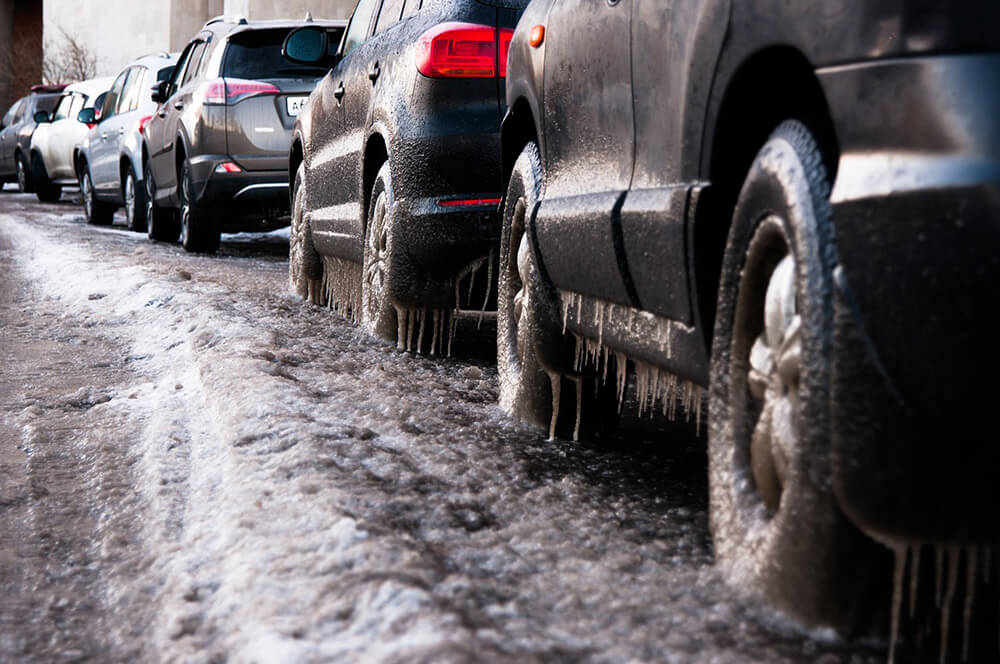Driving in cold weather can be beautiful—snow and ice on the trees, white covering the grass, and snow lingering on building roofs. Wintery scenes are peaceful, but when you start sliding on ice, you won’t feel that peace for long. When the temperatures drop and roads freeze, you could be in a lot of danger behind the wheel.
No matter how careful you are, you could find yourself sliding on ice. Whether you didn’t see it until it was too late, or it was black ice that you couldn’t see at all, when your car is sliding on ice, it’s terrifying—especially if you don’t know how to stop.
Try to take a deep breath and follow the steps listed below.
Stopping Your Car from Sliding on Ice
In most cases, the cause of a slide on the ice is from turning your wheel too quickly. This is what causes your wheels to slide on the ice and your car to potentially spin. This is a very dangerous situation, though. Here are the immediate actions to take when your car starts sliding on the ice so you can stop it as quickly and safely as possible:
- Take your foot off the gas.
- Don’t hit your brakes.
- Gently turn in the direction your back wheels are sliding.
- Don’t overcorrect the wheel, it could cause you to spin out.
- Keep your steering wheel straight if you are still moving straight.
- If you start to slide in the other direction, gently turn your wheel that way instead.
- Stay as calm as possible.
- Allow your car to slowly come to a stop.
- If you can’t avoid impact with another car or object, try to keep your body as relaxed as possible.
When you follow all of these steps, you should be able to safely stop your car from sliding on ice. As soon as you release your foot off the gas pedal, you should see a noticeable change in how your vehicle is reacting. While not having your foot on either pedal could seem counterintuitive, it’s your best option on ice.
That way, your wheels are moving naturally and aren’t being spun or stopped suddenly. This allows them to slow down more easily on the ice, and keeps you from being propelled forward, like you would if your foot was on the gas. Similarly, if your foot was on the brake, you’d be causing yourself to slide more. This is why removing your foot from both pedals is your best option.
Now that you know what to do in an emergency situation where your car is sliding, let’s look at some more preventative measures, like learning when ice could be a threat on the roads and tips for avoiding sliding on ice.
When Is Ice a Concern While Driving?
Before you get behind the wheel, it can be helpful to know if you might encounter ice based on weather conditions. There are a few hints that mean the roads could or do have ice on them. In Pennsylvania, winters can be hard, which means ice could show up at any point throughout the season. You need to be aware of the weather before driving so you know if ice is a possibility.
While the freezing point of water is 32 degrees Fahrenheit, that doesn’t mean ice only occurs below that temperature when that’s the reported temperature outside. Since a weather reading is an estimate of the air’s temperature, and not the ground, ice could actually be on the roads even if it’s 40 degrees outside.
The ground is typically colder than the air, which is why if it’s below 40 degrees in the air, that could mean the ground is below freezing and has ice on it. If it’s below 40 degrees outside and it’s currently raining or freezing rain, it rained or snowed recently, or the ground could be wet, then ice could be a concern while driving.
However, even if you think you’re in the clear, it’s always safe to be cautious and look out for ice even if you think it’s a little too warm.
Tips for Avoiding Sliding on Ice
Many times, by the time you’re sliding on a patch of ice on the road, it’s too late to avoid it. However, knowing how to avoid ice patches can be incredibly helpful in keeping you out of that situation. Here are some tips for you to know how to avoid ice while you’re driving so you can stay as safe as possible:
- Avoid driving in the rain, snow, or very cold conditions
- Don’t speed
- Slow down
- Accelerate slowly
- Don’t brake harshly—brake gradually
- Keep up with vehicle maintenance
- Get new tires when needed
- Watch for patches that look frozen or different from the road
- Stay calm and focused on the road
Pay attention to your surroundings and always stay alert while you’re driving, or make the smart decision to stay off the road when there is a possibility of icing over. Of course, it’s not always possible to avoid driving when it’s cold and icy, which is why you need to know how to avoid icy patches as well as how to stop your car when it slides on the ice.
Shrager, Sachs, & Blanco Can Help You
When you slide on the ice in bad weather conditions, you could easily get into an accident that causes injuries and other damages because you collide with an object or another vehicle. Our experienced car accident lawyer is prepared to help you recover compensation for the damages you’ve incurred so that you can focus on your physical and emotional healing.
At Shrager, Sachs, & Blanco, we’re dedicated to helping the victims of car crashes from sliding on ice, or any other cause of a wreck. When you’ve suffered damages, you could use the help of our attorneys. Reach out to our office today so we can get started working for you









